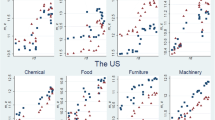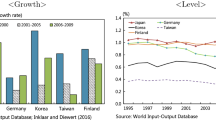Abstract
Using newly constructed panel data from seventeen OECD countries during 1971–2000, this paper examines the effect of international R&D spillovers via intermediate goods imports on a country’s productivity. Estimation models are built on the model of Coe and Helpman (1995). They are tested and estimated using improved econometric techniques for panel cointegration test and estimation. Estimation results confirm the robust positive effect of international R&D spillovers through the channel of intermediate goods imports. This contradicts recent skepticism about the results of Coe and Helpman (1995) that has been raised with the development of panel data econometrics.
Similar content being viewed by others
References
Chiang, M. and C. Kao (2002) “Nonstationary Panel Time Series Using NPT 1.3—A User Guide.” Center for Policy Research, Syracuse University.
Coe, D.T. and E. Helpman (1995) “International R&D Spillovers.” European Economic Review 39:859–887.
Coe, D.T. and A. W. Hoffmaister (1999) “Are There International R&D Spillovers Among Randomly Matched Trade Partners? A response to Keller.” Working Paper, International Monetary Fund.
Edmond, C. (2001) “Some Panel Cointegration Models of International R&D Spillovers.” Journal of Macroeconomics 23:241–260.
Funk, M. (2001) “Trade and International R&D spillovers among OECD Countries.” Southern Economic Journal 67:725–736.
Grossman, G.M. and E. Helpman (1991) Innovation and Growth in the Global Economy. Cambridge MA: MIT Press.
Hadri, K. (2000) “Testing for Stationarity in Heterogeneous Panel Data.” Econometrics Journal 3:148–161.
Im, K., M.H. Pesaran and Y. Shin (2003) “Testing for Unit Roots in Heterogeneous Panels.” Journal of Econometrics 115:53–74.
Kao, C. (1999) “Spurious Regression and Residual-Based Tests for Cointegration in Panel Data.” Journal of Econometrics 90:1–44.
Kao, C. and M. Chiang (2000) “On the Estimation and Inference of a Cointegrated Regression in Panel Data.” Advances in Econometrics 15:179–222.
Kao, C., M. Chiang and B. Chen (1999) “International R&D Spillovers: An Application of Estimation and Inference in Panel Cointegration.” Oxford Bulletin of Economics and Statistics 61:691–709.
Keller, W. (1988) “Are International R&D Spillovers Trade Related? Analyzing Spillovers among Randomly-Matched Trade Partners.” European Economic Review 42:1469–1481.
Levin, A., C. Lin and C. Chu (2002) “Unit Root Tests in Panel Data: Asymptotic and Finite Sample Properties.” Journal of Econometrics 108:1–24.
Lichtenberg, F.R. and B. van Pottelsberghe (1998) “International R&D Spillovers: A Re-examination.” European Economic Review 428:1483–1491.
Nicita, A. and M. Olarreaga (2001) “Trade and Production.” Working Paper, The World Bank, Washington DC.
Pedroni, P. (1999) “Critical Values for Cointegration Tests in Heterogeneous Panels with Multiple Regressors.” Oxford Bulletin of Economics and Statistics 61:653–670.
Pedroni, P. (2000) “Fully Modified OLS for Heterogeneous Cointegrated Panels.” Advances in Econometrics 15:93–130.
Pedroni, P. (2001) “Purchasing Power Parity Tests in Cointegrating Panels.” The Review of Economics and Statistics 83:727–731.
Pedroni, P. (2004) “Panel Cointegration; Asymptotic and Finite Sample Properties of Pooled Time Series Tests with an Application to the Purchasing Power Parity Hypothesis.” Econometric Theory 20:597–625.
Author information
Authors and Affiliations
Corresponding author
Rights and permissions
About this article
Cite this article
Lee, G. International R&D Spillovers Revisited. Open Econ Rev 16, 249–262 (2005). https://doi.org/10.1007/s11079-005-1024-0
Issue Date:
DOI: https://doi.org/10.1007/s11079-005-1024-0




